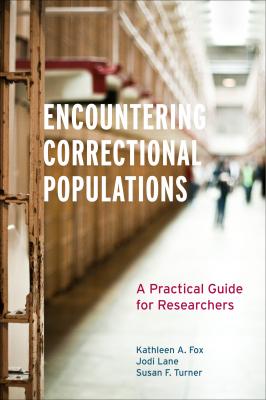Encountering Correctional Populations. Kathleen A. Fox
Чтение книги онлайн.
Читать онлайн книгу Encountering Correctional Populations - Kathleen A. Fox страница

Encountering Correctional Populations
Encountering Correctional Populations
A Practical Guide for Researchers
Kathleen A. Fox, Jodi Lane, and Susan F. Turner
UNIVERSITY OF CALIFORNIA PRESS
University of California Press, one of the most distinguished university presses in the United States, enriches lives around the world by advancing scholarship in the humanities, social sciences, and natural sciences. Its activities are supported by the UC Press Foundation and by philanthropic contributions from individuals and institutions. For more information, visit www.ucpress.edu.
University of California Press
Oakland, California
© 2018 by Kathleen A. Fox, Jodi Lane, and Susan F. Turner
Library of Congress Cataloging-in-Publication Data
Names: Fox, Kathleen A., author. | Lane, Jodi, 1967– author. | Turner, Susan, 1954– author.
Title: Encountering correctional populations : a practical guide for researchers / Kathleen A. Fox, Jodi Lane, and Susan F. Turner.
Description: Oakland, California : University of California Press, [2018] | Includes bibliographical references and index. |
Identifiers: LCCN 2017033397 (print) | LCCN 2017037977 (ebook) | ISBN 9780520966765 (ebook) | ISBN 9780520293564 (cloth : alk. paper) | ISBN 9780520293571 (pbk : alk. paper)
Subjects: LCSH: Criminology—Research—United States. | Corrections—Research—United States. | Criminal statistics—United States. | Correctional institutions—United States—Data processing.
Classification: LCC HV6024.5 (ebook) | LCC HV6024.5.F69 2018 (print) | DDC 365.072/073—dc23
LC record available at https://lccn.loc.gov/2017033397
Manufactured in the United States of America
27 26 25 24 23 22 21 20 19 18
10 9 8 7 6 5 4 3 2 1
Kate’s dedication:
To Chris, Jack, and Max Talbot
Jodi’s dedication:
To Chris and Cooper Wilson
Susan’s dedication:
To Stephen, Susie, and Tessa
Contents
2.Gaining Access to and Building Rapport with Correctional Populations
3.Types of Correctional Data That Can Be Collected
4.Informed Consent Process and Research Ethics
5.Logistics of Doing Research with Correctional Populations
Appendix A. Agency Letter of Support
Appendix B. Weekly Contact Sheet for Staff with Client Caseloads in the Experimental (SOCP) Group
Appendix C. Weekly Contact Code Sheet for Staff with Client Caseloads in the Experimental (SOCP) Group
Appendix D. Publically Available Data Sources
Appendix E. “Thinking for a Change” Facilitator Peer Rating Form
Appendix F. General Inforamed Consent for Traditional Placements in the Florida Faith and Community-Based Delinquency Treatment Initiative (FCBDTI)
Appendix G. Example of Re-Consent for Youths Participating in the Faith and Community-Based Delinquency Treatment Initiative (FCBDTI)
Appendix H. Informed Consent Form for Youth Interview
Appendix I. Example IRB Protocol
Appendix J. Application for a Research Assistant Position
References
Recommended Further Reading
Index
Illustrations
FIGURES
1.Recommended steps for gaining access to multiple facilities
2.Contact stamp for staff with client caseloads in the control (routine probation) group in SOCP
3.Transcription template
4.Example of an interview card to be handed to respondent
5.Interviewer assessment form
BOXES
1.Example verbiage to explain request to access jails
2.Building rapport with staff when the researcher has correctional experience
3.Examples of how to respond to an inmate touch
4.Examples of potential physical harm to participants and researchers and ways to reduce risk
5.Examples of potential psychological harm to offenders and ways to reduce risk
6.Examples of potentially coercive situations and ways to avoid coercion
7.The case of Rick Scarce’s ethical dilemma
8.Example of incomplete disclosure used by the authors